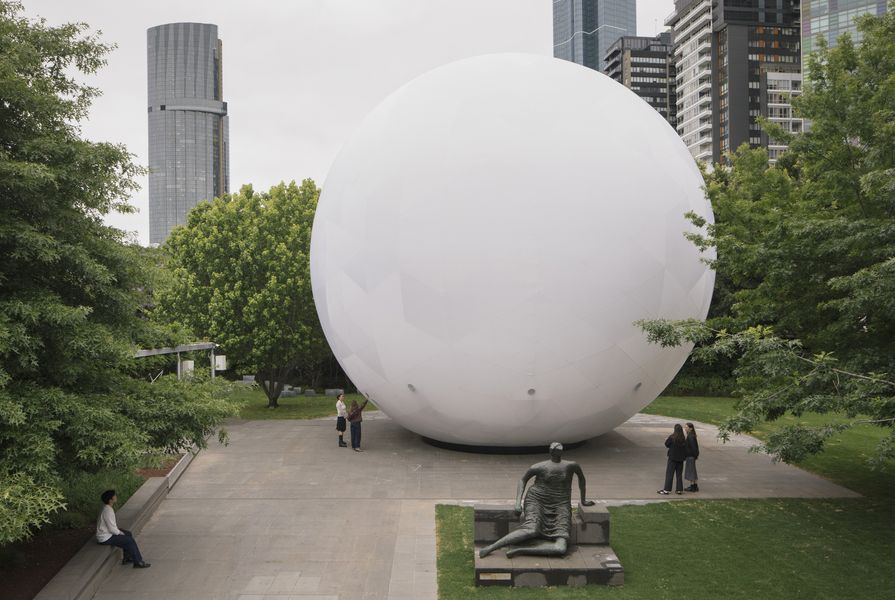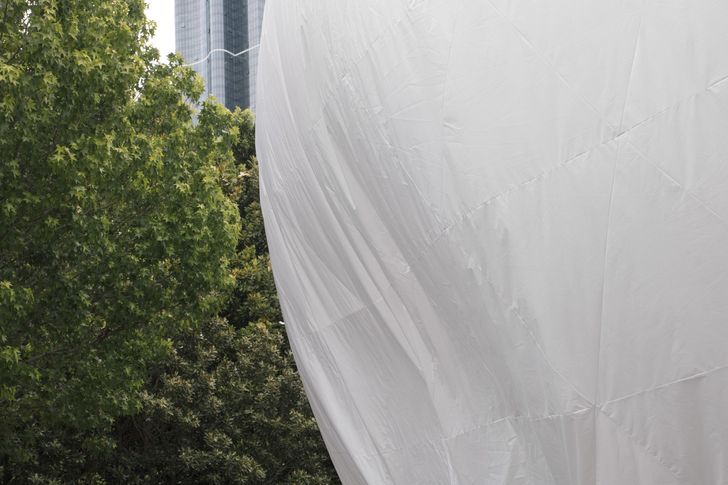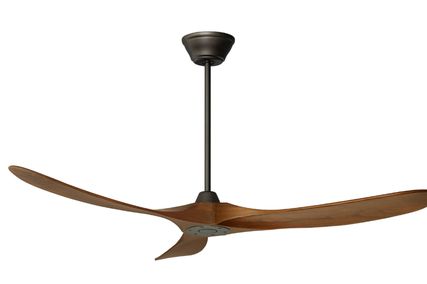Air has been topical in the 2020s. MONA’s Oceans of Air, an exhibition of Argentine artist Tomás Saraceno’s work, coincided with QAGOMA’s Air, a collection by Australian and international artists exploring the multifaceted dimensions of our shared atmosphere. Air pollution and environmental crises – topics rendered all the more pertinent as airborne disease dominated the start of the decade – regularly come up in built environment design practice.
(This is) Air, the National Gallery of Victoria’s eighth architecture commission program, neatly slots into this overarching context. The media release suggests that the installation “draws attention to one of the universal and defining features of life on earth: breathing air” and “evokes a sense of uplifting optimism.” When I saw renders of it in 2022, I was intrigued by what in some ways resembled a giant poached egg billowing in the wind. Further, I thought the act of “making the invisible visible” was a clever fit for two of the 2023 Triennial themes: “matter” and “magic.”
I first visited (This is) Air on a calm, quiet afternoon. As I passed the gallery’s Waterwall and crossed the foyer, the installation’s giant white sphere appeared on the horizon, enticing visitors through the Great Hall and into the NGV Garden. Perched on the pavement, the work loomed over visitors and other artworks placed around the lawn. It offered a subtle, minimalist backdrop for Henry Moore’s Draped Seated Woman. No didactic plaque was (easily) in sight.
A smattering of visitors lounged in the shade, perhaps taking a break from the multisensory overload of the current Triennial. Others ventured up to the sphere, touched it, affably perched on its base, and wandered away looking pleasantly bemused. The ball’s “breathing” more closely resembled that of a mechanical lung than a living being; air expelled from valves near the base let out a gentle but perceptible hiss. Despite knowing the “breathing” speed before my visit, I was surprised at how slow it was. Although I sat by the work for at least 40 minutes that afternoon, the overall deflation was hard to detect.
My second visit – this time on a blustery day – was radically different. Half-deflated, buffeted by strong gusts, the previously buoyant and benign sphere menacingly rolled on its base. It had become chaotic and unpredictable, drawing squeals of wonder and alarm from onlookers who could now perceive the force of the structure that bore down on them. Fascinated by the contrast this made to my first visit, I joined the crowd, sharing its tentative steps toward the sphere – and its subsequent moment of panic. This was air with weight! Technically, of course, the weight came from the structure … but in that crowd, I had the impression of being confronted by the gravity of the air.
What the designers have created is a barometer of prevailing atmospheric conditions that draws attention to weather and is, at times, both visually and spatially engaging.
Image: Benjamin Hosking
Does (This is) Air therefore remind us that this collective planetary resource is immeasurably precious? On balance, not quite. The ball’s “breathing” isn’t frequent enough; and while I could hear and feel air being released through the valves, the impression I had was of a slowly deflating bouncy castle or beach ball – not a living, breathing being. The built project also lacks the enigmatic quality that made the original renders so beguiling, perhaps demonstrating that even that which is revealed can remain elusive.
What the designers have created is a barometer of prevailing atmospheric conditions that draws attention to weather and is, at times, both visually and spatially engaging. To really appreciate the work, however, repeat visits in different weather conditions are required. I’m yet to see any photos or videos on popular media or the NGV website that convey this dynamism – a pity, I think, as I found it the work’s most compelling aspect. Seeing air not just as a precious and fragile resource essential for all life but as a major, tumultuous force shaping the built and natural environment opens up different ways of approaching it in various disciplines. Maybe this is what (This is) Air invites us to consider – even if it’s not exactly what the designers had in mind.
The nature of (This is) Air also makes me wonder about the future of the program’s commissions. Architects have long created works that aren’t purely about buildings (and the NGV collects and exhibits them). Does (This is) Air mean we will be seeing more sculptural pieces being developed, rather than structures for occupation and inhabitation? I’m excited to see what comes next.



















